Telecoms are rapidly changing, and a reliable testing and troubleshooting method is becoming increasingly important. Fiber optic technology has superior speed and time, so it has been accepted in many sectors. Loopback connectors are at the heart of this technology, the most conspicuous being the MPO (Multi-fiber Push On) loopback connector, which is essential in performance assessment. In as much as this guide explains the primary use of the MPO loopback connector, it also covers its operation, dimensions, and expected use so that the reader appreciates its role in proper network functionality. This article aims to present the fiber optic loopback adapters in detail to provide professionals and working amateurs with a specific understanding of the fiber optic systems in use.
What is an MPO Loopback Connector?

Overview of MPO Loopback Adapters
MPO loopback adapters are also described as tools capable of giving feedback, thus ensuring that the establishment’s optical networks are well-tested and approved. In particular, these adapters use many optical fibers that direct the signal back toward the originating point so that the related operators can determine whether the specific network equipment is working or not. The testing formalities and procedures have been simplified, most notably because of the MPO connector that allows the connection of factory-fused small fiber optic cables into one interface. Many designs are available for the MPO loopback adapters, including those supporting the single mode and multi mode fiber, therefore enhancing the capabilities of maintaining the signal in desired parameters for different applications and improving the overall network performance.
Key Components of a Loopback Connector
In optical networks, Loopback connectors incorporate several fundamental components that allow for effective signal routings as well as testing, and these are:
- Connector Housing: The outer casing, which is usually constructed from a strong material, protects the inner fibers and components and provides a stable point for the MPO connector.
- Optical Fibers: Inside the connector, there are more specifics that transmit light. In the MPO loopback, several fibers are bundled together to achieve the desired return, which is why the same use is made of the notch.
- Mechanism of Alignment: This part is essential for holding the fibers correctly in place for efficiency during transmissions and testing.
- Polishing of Endface: The strength of the end face polish of fibers influences the quality of the connection. If the end face is well polished, scattering is reduced, thereby enhancing the transmission of light.
- Testing Port: The extent to which users perform this is limited to a particular model that has incorporated an external testing port, which enables the device connector to quickly connect to testing tools without switching the primary connection.
All these components aid in circumventing the weaknesses of optical network testing and ensuring that the network, if not all its aspects, performs, delivers, and functions properly.
Applications in Testing and Troubleshooting
Loopback connectors play an essential role in many testing and maintenance procedures, with special emphasis on cable assembly, in the context of optical networks. These are mainly used in closed-loop testing, where active network equipment is tested. By doing this, the technicians can determine the transmission quality when a signal is transmitted and a reception is made. In a related context, loopback connectors make it possible to conduct network diagnostics by testing connections and resolving whether the problem is with the connection device or the network. They also facilitate the calibration of optical devices by ensuring a reasonable way of comparing the system performance across the devices since that is necessary to ensure service quality in a network. In general, loopback connectors are used to improve the efficiency and accuracy of network testing procedures.
How Does a Loopback Adapter Work?

The functionality of MPO Loopback Connectors
The design of the MPO loopback connector provides ease of optical network testing because of its compact shape and the ability to handle several fibers at once, which is why they made it an MPO or multifiber push-on. Such connectors create a closed-loop connection for transmission and receiving through the same optical interface. This is a key feature for network optics testing because the engineers can test the whole link by passing light through different fibers within a single framework. The MPO loopback connectors are also available in many configurations, such as standard pinouts and custom pinouts for specific types of MPO connectors, thus enabling comprehensive testing. By using the MPO loopback connectors, not only the speed and efficiency of the network diagnostics is improved, but the action of performance benchmarking across interconnected networks is much more effective.
How Loopbacks Ensure Network Integrity
Loopbacks are essential in maintaining the integrity of the network by enabling testing and health assessment of the network connections. Loopbacks are employed by sending outgoing signals back in, thus allowing the network manager to find areas where there is signal loss, problems in the configuration of devices, or equipment problems. Such testing methodology provides a means to assess the physical cable and the logical methods of data transfer and ensures that the network equipment performs as anticipated. In addition to that, loopbacks can also be used as load generators, and thus, the actual performance of the operation can be evaluated. Implementation of periodic loopback tests allows organizations to preempt any kind of faults before they reach end users, thus enhancing the reliability and uptime of the networks.
Use in Data Centers and Optical Networks
This treatment is timeless, however, and much more than one involves one of three classes of activists because it is designed and documented to help you read using the kind of data that existed in graphical form to capture network activity. In those environments, external testing for validation of multi-fiber links can often be accomplished. Because of the many design configurations offered by MPO loopback connectors, it is easy to validate the fiber-optic routes even during maintenance or repairs. In optical networks, these loopbacks are also used to initiate performance tests where the technicians check the connection’s performance both ways, even when the connections are operational. This is important in maintaining an acceptable level of service in cases of congestion when data transmission must continue without interruptions. Continual loopback testing makes it easier to identify trouble areas such as congestion in the media which may cause service degradation.
What Are the Different Types of MPO Loopback Connectors?

Singlemode vs. Multimode Loopbacks
As in every aspect of their use, singlemode and multimode loopback connectors have different objectives in telecommunication testing, especially in fiber optics. Singlemode loopback connectors are employed where singlemode fiber (SMF) is in place, a fiber with a smaller core diameter (around 8 to 10 microns), and a longer distance usage of signals with less modal dispersion. Such loopbacks are perfectly suited for high bandwidth utilization, so long-haul optical networks can be tested well.
On the other hand, multimode loopback connectors are those that are for masts with rather wider core diameter (50 or 62.5 microns) multimode optical fibers and are designed in such a way that they cannot only support Mpo Fiber Loop but are also able to support such fibers more effectively for short distances. This is effective for short distances, such as within data centers or within premises where bandwidth is problematic. Whether one utilizes singlemode or multimode loopbacks will highly depend on the existing infrastructure or the intended intention since factors like distance, bandwidth, and data loss are paramount.
12-Core MPO Connectors
The main aim of using 12-core MPO (Multi-Fiber Push On) connectors in high-density optical networks has always been the economy of space, which enables the effective management of such optical connections. Such connectors can house twelve optical fibers in one housing, thus reducing the required space for cabling in the workplace networking environment. This feature is helpful in data centers and enterprise networks where space and scalability are crucial.
Nevertheless, 12-core MPO connectors for singlemode and multimode applications offer the most flexible options to modulate the networks in any deployment type. These designs are also central to the rapid construction and adjustment of fiber networks, which can easily be plugged or unplugged without special tools. It is essential, however, to ensure proper termination and adherence to optical performance specs when mounting 12-core MPO connectors to achieve good optical performance and avoid losses due to connection.
Female Loopback Connectors
Pink female loopback connectors are the most commonly used devices during network tests and diagnostics. Using the warm body forwards outgoing signals. Images of the transmitter are assessed, and the network’s integrity, namely echo signals, is checked without any encoding loss. They can be made for different types of fibers, singlemode and multimode being some, and used where the core of the networks behaves differently. A female loopback connector.
This type of loopback connector is instrumental in assessing transceivers and network equipment because it can reveal deficiencies in the test, such as loss, disturbances, and heavyweight. No bigger-than-necessary designs allow those loopback adapters to be installed in the existing structure, helping test more quickly and increasing the efficiency of the wires containing loop adapters. These connectors should be durable and flexible enough to include them in bound technical activities without compromising testing quality and effectiveness.
Why Choose Multimode OM3 MPO Loopback Adapters?

Advantages of Multimode OM3
Multimode OM3 MPO loopback adapters are specifically tailored to fulfill the demands of modern networking solutions. First, OM3 fibers are designed to carry high bandwidth signals, including 10 Gbps Ethernet up to distances of 300 meters, thus making them suitable for data center technology and enterprise network environments. Second, MPO connectors are lightweight and compact, which makes them easy to install and manage in covered and cramped spaces. Third, OM3 fibers reduce modal dispersion and thus preserve joint optical signal integrity over longer distances than other earlier modalities for multimode optical standards. Fourth, such adapters work with many different protocols, allowing for versatility of use in various systems irrespective of the application – whether for testing or as permanent links. In conclusion, using multimode OM3 MPO loopback adapters increases a network’s efficiency, reliability, and performance, which are essential in such hostilities.
Use Cases in High-Speed Data Applications
Multimode OM3 MPO loopback adapters are constructed commonly, forming an integral part of most high-speed data applications and networks, especially within data centers and organizations. These are crucial tools for network performance assessment designed to enable engineers to conduct tests and troubleshoot without the arduous setups usually involved. For example, in some situations like those in the cloud and virtualized environments where bandwidth is a significant concern, these adapters help keep the data flowing along and eliminate any delays. Moreover, they are of utmost importance in testing the network gear before installation to ensure that the transceivers will achieve the desired quality of service. Thus, using OM3 MPO loopback adapters improves the efficacy and dependability of high-data applications in diverse environments.
Reliability and Performance in Testing Applications
Multimode OM3 MPO loopback adapters are essential for enhancing testing processes in various applications by increasing system reliability and performance. These adapters are meant to maintain stable and correctly oriented connections, which are crucial for evaluating network performance and troubleshooting. Because of the loopback feature, simple testing methods allow network technicians to conduct tests on switches, routers, and other related devices without using extra machines. In addition to that, the use of OM3-rated cables minimizes signal loss, which enhances test quality and dependability. In testing environments where the accuracy of the result is critical, the attachment of these adapters not only makes the testing processes easier but also maintains the quality of the network by ensuring that any performance issues are detected and fixed within the shortest time possible.
Installation and Testing of MPO Loopback Connectors

Step-by-Step Installation Guide
- Gather Required Tools and Materials: Gather all the necessary tools, such as a fiber patch cable, cleaning tools, an optical power meter, and the OM3 MPO loopback adapter.
- Prepare the Workspace: Set up a clean, static-free working environment to reduce the chances of contaminating the optical connectors, especially while working with MT ferrule connectors.
- Inspect the MPO Loopback Adapter: Examine the MPO loopback adapter for any signs of physical damage. To attain a good connection, the MPO connectors should be cleaned using the right cleaning wipes.
- Connect the Adapter: Insert the loopback adapter’s MPO connector into the device’s MPO port that you wish to test. Ensure that it is reinserted snugly to prevent poor connectivity.
- Connect the Testing Equipment: If needed, connect an optical power meter to the device’s optical port with a fiber patch cable.
- Perform Testing: Go ahead and carry out the test you want to conduct with the equipment in question, ensuring that the adapter is looped in for the circulation of data. Note the readings provided by the optical power meter or any network analysis tools, and note the same while using a female fiber optic loopback adapter.
- Analyze Results: Upon testing, the next step involves evaluating the performance metrics seized during the process to guarantee that all echo signals conform to parallel specifications. Any disparities observed should also be rectified to ensure that the said equipment meets the specified standards, especially for qsfp systems.
- Remove and Store: After the testing procedure has been finalized, the MPO loopback adapter should be detached from the apparatus with caution. It should be kept in a specific place to preserve its performance for the next time it is needed.
Through these steps, the efficient installation and testing of the MPO loopback connectors will be enhanced, thereby ensuring accurate performance measurement and reliable network management.
Testing Procedures for Loopback Adapters
Loopback adapter testing policies tend to have specific procedures in place to make the evaluation of the performance and continuity of the network as accurate as possible. First, a connection via the loopback adapter is made, as outlined earlier in the preceding steps. After this point, choose the appropriate testing tool, whether an optical time domain reflectometer (OTDR) when testing signal continuity or a network protocol analyzer when checking the network performance. Test signals are then injected, and the return signals are monitored for the correct parameters, including loss thresholds and return loss values. Take all possible readings and process them to determine any existing signal transmission guarantee. Finally, the results are crosschecked with the industry or manufacturer standards to confirm operational performance. This procedure ensures that loopback adapters are comprehensively tested and network elongation is maximized.
Common Issues and Troubleshooting Tips
The use of loopback adapters can sometimes negatively affect how effective testing and networking would typically be. Here, then, are some possible solutions to these problems:
- Signal Loss: Reduced signal level. Signal loss at the loopback device is often the most severe problem or issue. We can clean every connection and inspect the connectors for damage. In particular, are the connectors of the fiber optic cables checked for damage.
- Inaccurate Set-Up: The testing machines should be properly set up to identify or detect the loopback adapter. It is advisable to review the wavelength and test parameter settings since inappropriate configurations often produce unreliable results, especially with loopback configurations.
- Extraneous noise: Testing processes can also produce unwanted signals. Disruptions should be reduced to a minimum, and tests should be done in a shielded environment or with shielded cables where required in optical fiber systems.
- Unit Tuning: Testing devices should also be calibrated periodically, especially with single-mode and multimode fibers. To ensure correct test results, all devices, including OTDRs and analyzers, should be checked to ensure they are calibrated in accordance with equipment manufacturer specifications.
Thus, by addressing most of the issues in this manner, the users improve the quality of the testing processes and the network’s performance, too.
Reference Sources
Frequently Asked Questions (FAQs)
Q: What is an MPO Loopback Connector?
A: An MPO Loopback Connector is simply a fiber optic loopback adapter that facilitates testing network equipment’s transmission capability and receiver sensitivity by returning the transmitted signal to the transmitter. It helps appropriately communicate optical cable lines so they are not disrupted and the correct signal returns.
Q: How does an MPO fiber loopback with housing work?
A: An MPO fiber loopback with housing works by creating a loop from the optical transceiver by connecting the transmit and receive lines, thus bridging the two lines and creating a complete path for the signal. This makes it possible to test and check the performance of the transceiver and the condition of the fiber optic network.
Q: What is the significance of low loss in an MPO Loopback Connector?
A: Low loss in an MPO Loopback Connector is important to limit insertion loss, which is the loss of signal power associated with the connector’s insertion. The low loss thus ensures high performance and testing accuracy of fiber optic networks.
Q: What networks are usually associated with the use of MPO Loopback Connectors?
A: In fact, these devices are most often used in high-speed data networks, e.g., data centers, telecommunications, enterprise networks, and applications involving 100g ethernet and parallel optics. They are MPO loopback connectors.
Q: Why should there be accuracy when using an MPO Loopback Connector?
A: Accuracy is paramount when dealing with an MPO Loopback Connector to maintain the integrity of the optical fiber testing process. For example, an optic loopback adapter with a precision ceramic ferrule provides considerable alignment accuracy and is an effective way of improving testing while reducing signal loss.
Q: How do MPO or MTP® fiber optic connectors differ?
A: MTP® is a proprietary term for a switch-mode, high-performance MPO (Multi-Fibre Push On) connector. Compared to an MPO fiber connector, an MTP® connector is built with better design intent for mechanical and optical performance parameters, including proper orientation and reduced Machining loss.
Q: What measures are there to test the quality of an MPO Loopback Connector?
A: To validate the quality of an MPO Loopback Connector, functional tests ideally have to be conducted to industry standards like those of IEC. This incorporates testing for numerous possible defects of concern, such as excessive insertion loss or inadequate alignment performance, to guarantee dependability.
Q: What are the primary uses of an MPO Loopback Connector?
A: An MPO Loopback Connector is used for optical fiber testing such as fiber optic link testing, testing of connectors, diagnostic testing of the network, and equipment development, especially for qsfp cable assembly. They are used as test plugs when applying applications in conditions requiring high-speed data transmission and practical network functionality.
Q: What is a 12-core MPO connector multimode OM3?
A: A 12-core MPO connector is a type of MPO connector with 12 optical fiber termination and provides a high rate of performance for transmission over multimode optical cable, such as those used for 100g Ethernet and other similar applications.
Related Products:
-
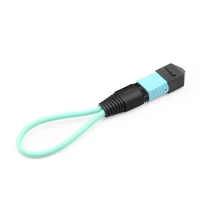 12Fibers MPO APC Female OM4 50/125 Multimode Fiber Loopback Cable
$17.00
12Fibers MPO APC Female OM4 50/125 Multimode Fiber Loopback Cable
$17.00
-
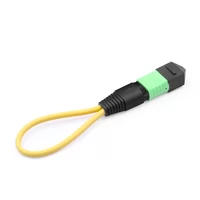 12 Fibers MPO APC Female OS2 9/125 Single Mode Fiber Loopback Cable
$14.00
12 Fibers MPO APC Female OS2 9/125 Single Mode Fiber Loopback Cable
$14.00
-
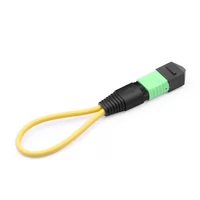 8 Fibers MPO APC Female OS2 9/125 Single Mode Fiber Loopback Cable
$14.00
8 Fibers MPO APC Female OS2 9/125 Single Mode Fiber Loopback Cable
$14.00
-
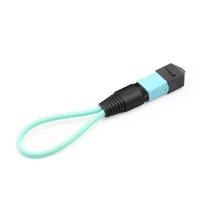 16 Fibers MPO APC Female OM4 50/125 Multimode Fiber Loopback Cable
$14.00
16 Fibers MPO APC Female OM4 50/125 Multimode Fiber Loopback Cable
$14.00
-
 12 Fibers MPO UPC Female OM4 50/125 Multimode Fiber Loopback Cable
$12.00
12 Fibers MPO UPC Female OM4 50/125 Multimode Fiber Loopback Cable
$12.00
-
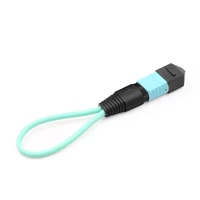 8 Fibers MPO APC Female OM4 50/125 Multimode Fiber Loopback Cable
$15.00
8 Fibers MPO APC Female OM4 50/125 Multimode Fiber Loopback Cable
$15.00
